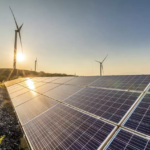The Top 10 Solar Power Plants in India are a diverse and impressive list of projects that showcase the country’s commitment to harnessing the power of the sun. From the world-renowned Bhadla Solar Park to the innovative IB Solar panels, and the massive Adani Solar development, each of these projects represents a unique and innovative approach to solar energy.
Please add images for all the solar parks individually
1. Bhadla Solar Park, Rajasthan

The world’s largest solar park, Bhadla is located in an inhospitable region with extreme heat and frequent sandstorms. Despite this, the park has a capacity of 2,245 MW and is set to become the world’s largest fully commissioned PV project.
2. Pavagada Solar Park, Karnataka

Spread over an area of 53 square kilometres, Pavagada Solar Park is the world’s second-largest photovoltaic solar park with a capacity of 2,050 MW, powering 5 villages in the region.
3. Kurnool Ultra Mega Solar Park, Andhra Pradesh

Spread over an area of 53 square kilometres, Pavagada Solar Park is the world’s second-largest photovoltaic solar park with a capacity of 1000 MW.
4. NP Kunta – Andhra Pradesh

The NP Kunta Ultra Mega solar park with a capacity of 978.5 MW located in Nambulapulakunta Mandal of Kadiri Constituency in Sri Sathya Sai district of Andhra Pradesh boasts a total area of 32 square kilometers. This sprawling solar park, also known as Ananthapuram-I Ultra Mega Solar Park or Kadiri Ultra Mega Solar Park, is just 35 km away from the city of Kadiri.
The park’s first phase was commissioned on May 9th, 2016 with a capacity of 200 MW. An additional 50 MW was added on July 29th, 2016. The second phase, which was planned to have a capacity of 750 MW, was expected to be commissioned by March 2018.
5. Charanka Solar Park, Gujarat

Initiated in 2012 by the Chief Minister of Gujarat Narendra Modi, it was home to around 250 MW limit at first. On 19 April 2012, a sum of 214 megawatts (287,000 hp) was commissioned.[2] It likewise turned into the world’s third biggest photograph voltaic power station.
The venture’s essential designer, the Gujarat Power Organization Restricted (GPCL) said in April 2018 that further limit expansion of 150 MW taking them all out to 790 MW might be settled on before long given the accessibility of land in the Park.
The introduced age limit is at around 615 MW as of now, having been appointed by 31 engineers in the Sun-powered Park. GACL (Gujarat Alkalies and Synthetic substances Restricted) is setting up a 30 MW Sunlight based PV plant, and GNFC (Gujarat Narmada Valley Manures and Synthetics) is currently setting up a 10 MW project.
6. Rewa Ultra Mega Solar, Madhya Pradesh

Rewa Ultra Mega Solar is a pioneering project in India, as it is the first to break the grid parity barrier and is one of the largest solar power plants in the country and Asia of 750 MW Rewa Ultra Mega Solar Power Project (Rewa UMSPP) is one of the largest single-site solar power plants in the world, which is spread over an area of 1590 hectares in the Rewa district of Madhya Pradesh.
The project is implemented by Rewa Ultra Mega Solar Limited (RUMSL), a joint venture between Madhya Pradesh Urja Vikas Nigam Limited (MPUVNL) and the Solar Energy Corporation of India (SECI). Additionally, it is the first project in India to supply power to an inter-state open-access customer, such as the Delhi Metro, and also the first to use solar power for railway traction.
7. Kamuthi Solar Power Project, Tamil Nadu

Kamuthi Solar Power Project – Spread over an area of 2,500 acres in Tamil Nadu, the Kamuthi Solar Power Project is a large-scale photovoltaic power station that showcases India’s dedication to sustainable energy.
8. Ananthapuramu – II, Andhra Pradesh

Ananthapuramu-II Ultra Mega Solar Park is a one-of-a-kind solar project, currently owned by Andhra Pradesh Power Generation. Spread over 1,000 acres of land, the project generates 446GWh of electricity and is capable of powering 150,000 households, offsetting 246,000 tons of carbon dioxide emissions (CO2) annually.
The project also boasts an impressive cost of $206.84 million and comprises 848,680 modules. This project is a major milestone in the state’s journey towards clean and sustainable energy production. It is a unique example of how large-scale solar projects can make a significant impact on the environment and the community by reducing carbon emissions and providing clean energy.
9. Galiveedu solar park, Andhra Pradesh

Galiveedu Ananthapuramu Mega Solar PV Park is a ground-mounted solar project planned in Andhra Pradesh, India. Currently, in the announced stage, the project will be developed in a single phase and is expected to commence construction in 2022, with commercial operation beginning in 2024. With an estimated cost of $69.8 million, this project will be a major milestone in the state’s transition toward clean and sustainable energy production.
This project is unique in its location and size of the project, as it is planned in Ananthapuramu which is known for its rich cultural heritage and ancient temples, this project will not only help in reducing the carbon footprint but also provide clean energy to the local community while preserving the cultural heritage of the place. This project is a perfect example of how renewable energy can be implemented without compromising on the natural and cultural heritage of a place.
10. Mandsaur Solar Farm, Madhya Pradesh

Mandsaur Solar Farm is a 250 MW power plant in Madhya Pradesh, built mainly on non-agricultural land using domestically manufactured solar cells and modules. It was developed by NTPC under the “Make in India” initiative and inaugurated in 2018 by the chief minister of Madhya Pradesh. This is one of the largest solar plants in the state and the country, with an investment of INR 1,500 crore.
India has truly emerged as a global leader in the field of renewable energy, particularly in the development of large-scale solar projects. From the Bhadla Solar Park, the world’s largest solar park to the Kurnool Ultra Mega Solar Park, the country boasts an impressive portfolio of solar projects that showcase its commitment to sustainable energy.
Additionally, projects like Rewa Ultra Mega Solar and Mandsaur Solar Farm have set new benchmarks in the renewable energy sector by breaking grid parity barriers and using domestically manufactured solar cells and modules. This not only promotes self-reliance but also helps in the creation of jobs in the country.
One such company that is making a significant contribution to India’s growing renewable energy sector is IB Solar. With its state-of-the-art manufacturing facility in Noida and an annual capacity of 90 MW, the company has been providing high-quality solar cells and modules to various solar projects. The company has plans to upgrade its capacity to 500MW by 2023, which will greatly contribute to India’s ambitious renewable energy goals.
In conclusion, India’s growing portfolio of large-scale solar projects and the contributions of companies like IB Solar, showcase the country’s dedication to sustainable energy and its potential for large-scale renewable energy development. With such a wide range of initiatives being implemented, India is well on its way to achieving its renewable energy goals and promoting sustainable development.






Leave a Reply